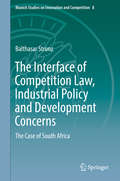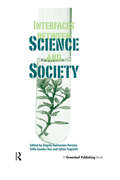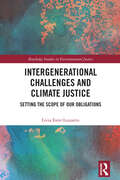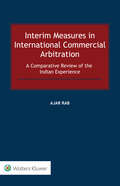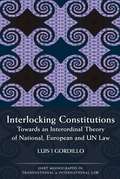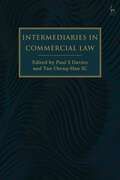- Table View
- List View
Interest in International Arbitration (Oxford International Arbitration Series)
by Matthew SecombInterest plays a vital and increasing role in international arbitration proceedings, with almost every case having an element of interest involved. However, until now, the topic has received very little attention, meaning that arbitrators have had very little concrete foundation on which to judge decisions on interest awards. This book is the first authoritative guidance to address this, providing a uniform approach to the awarding of interest in international arbitration. Interest in International Arbitration aligns arbitrators' decisions with standard commercial practice, offering a practical and logical approach to how interest should be awarded. It sets out traditional approaches that arbitrators have followed in the past, such as using conflict of law to apply a statutory rate from a given law, or awarding instead a subjectively 'reasonable' rate, and examines how these inconsistent approaches have resulted in a variety of awards and decisions. The author uses this analysis as a basis for a uniform approach to the issue: granting compound interest at appropriate rates unless constrained by truly mandatory law. The author sets out the calculation method, explores the benefits and limitations, and presents a thorough argument for the movement toward a uniform approach to interest awards.
Interest in International Arbitration (Oxford International Arbitration Series)
by Matthew SecombInterest plays a vital and increasing role in international arbitration proceedings, with almost every case having an element of interest involved. However, until now, the topic has received very little attention, meaning that arbitrators have had very little concrete foundation on which to judge decisions on interest awards. This book is the first authoritative guidance to address this, providing a uniform approach to the awarding of interest in international arbitration. Interest in International Arbitration aligns arbitrators' decisions with standard commercial practice, offering a practical and logical approach to how interest should be awarded. It sets out traditional approaches that arbitrators have followed in the past, such as using conflict of law to apply a statutory rate from a given law, or awarding instead a subjectively 'reasonable' rate, and examines how these inconsistent approaches have resulted in a variety of awards and decisions. The author uses this analysis as a basis for a uniform approach to the issue: granting compound interest at appropriate rates unless constrained by truly mandatory law. The author sets out the calculation method, explores the benefits and limitations, and presents a thorough argument for the movement toward a uniform approach to interest awards.
The Interface between Competition and the Internal Market: Market Separation under Article 102 TFEU (Hart Studies in Competition Law)
by Vasiliki BrisimiThis book explores the interface between competition law and market integration in the application of Article 102 of the Treaty on the Functioning of the European Union (TFEU), focusing on the notion of 'market separation'-namely conduct that may hinder cross-border trade. The discussion reviews, among other things, the treatment of geographic price discrimination and exclusionary abuse, by which out-of-state competitors are affected. 'Market separation' cases are treated in the book as a case study for appraising the interface between competition and the Internal Market. On this basis, the book provides a comparative analysis of the Treaty requirements under Article 102 TFEU when applied in 'market separation' cases and the Treaty requirements under the free movement provisions. In addition, it utilises 'market separation' cases as a springboard for advancing an informed reformulation of the application of Article 102 TFEU when state action comes into play.All in all, the analysis presented in the book deconstructs the elements for establishing 'market separation' as an abuse of the dominant position. It shows that there is nothing that would justify a distinctive treatment of 'market separation' under Article 102 TFEU, other than a principled understanding of Internal Market law as a whole: whatever understanding one reaches about the proper shape of the Internal Market, interrogation of the proper application of competition law comes after that and thus should be informed by this understanding.
The Interface between Competition and the Internal Market: Market Separation under Article 102 TFEU (Hart Studies in Competition Law #9)
by Vasiliki BrisimiThis book explores the interface between competition law and market integration in the application of Article 102 of the Treaty on the Functioning of the European Union (TFEU), focusing on the notion of 'market separation'-namely conduct that may hinder cross-border trade. The discussion reviews, among other things, the treatment of geographic price discrimination and exclusionary abuse, by which out-of-state competitors are affected. 'Market separation' cases are treated in the book as a case study for appraising the interface between competition and the Internal Market. On this basis, the book provides a comparative analysis of the Treaty requirements under Article 102 TFEU when applied in 'market separation' cases and the Treaty requirements under the free movement provisions. In addition, it utilises 'market separation' cases as a springboard for advancing an informed reformulation of the application of Article 102 TFEU when state action comes into play.All in all, the analysis presented in the book deconstructs the elements for establishing 'market separation' as an abuse of the dominant position. It shows that there is nothing that would justify a distinctive treatment of 'market separation' under Article 102 TFEU, other than a principled understanding of Internal Market law as a whole: whatever understanding one reaches about the proper shape of the Internal Market, interrogation of the proper application of competition law comes after that and thus should be informed by this understanding.
The Interface Between EU and International Law: Contemporary Reflections (Modern Studies in European Law)
by Inge Govaere Sacha GarbenDespite their many obvious interconnections, EU and international law are all too often studied and practised in different spheres. While it is natural for each to insist on its own unique characteristics, and in particular for the EU to emphasise its sui generis nature, important insights might be lost because of this exclusionary approach. This book aims to break through some of those barriers and to show how more interaction between the two spheres might be encouraged. In so doing, it offers a constitutional dimension but also a substantive one, identifying policy areas where EU and international law and their respective actors work alongside each other. Offering a 360-degree view on both EU and international institutional and substantive law, this collection presents a refreshing perspective on a longstanding issue.
The Interface Between EU and International Law: Contemporary Reflections (Modern Studies in European Law)
by Inge Govaere Sacha GarbenDespite their many obvious interconnections, EU and international law are all too often studied and practised in different spheres. While it is natural for each to insist on its own unique characteristics, and in particular for the EU to emphasise its sui generis nature, important insights might be lost because of this exclusionary approach. This book aims to break through some of those barriers and to show how more interaction between the two spheres might be encouraged. In so doing, it offers a constitutional dimension but also a substantive one, identifying policy areas where EU and international law and their respective actors work alongside each other. Offering a 360-degree view on both EU and international institutional and substantive law, this collection presents a refreshing perspective on a longstanding issue.
The Interface between Intellectual Property and Investment Law: An Intertextual Analysis (Elgar Intellectual Property and Global Development series)
by Emmanuel K. OkeThis original book presents a critical analysis of the interface between international intellectual property law and international investment law through the lens of intertextuality. It argues that a structuralist approach to intertextuality can be useful in the context of legal interpretation, especially in relation to the interpretation of treaties.Emmanuel Kolawole Oke critically evaluates the assumption that investment tribunals cannot take the rules of international intellectual property law into account when resolving investment disputes concerning intellectual property rights. He demonstrates instead the ways in which investment tribunals can and should adopt an intertextual approach when resolving such disputes, which, in turn, will help to preserve the intellectual property policy space of host states.Providing useful and thought-provoking insights, this book will be beneficial for legal scholars and students in the fields of intellectual property law, international investment law, and human rights. It will also be of great assistance to arbitrators faced with investment disputes involving intellectual property rights, as well as policy makers engaged in the negotiation of trade and investment agreements.
The Interface of Competition Law, Industrial Policy and Development Concerns: The Case of South Africa (Munich Studies on Innovation and Competition #8)
by Balthasar StrunzThis book analyses essential concepts of competition law and industrial policy, and shows where the two areas clash with and complement each other, respectively. The discussion takes place in the context of developing countries, taking into consideration their realities and specific needs. South Africa serves as a real-world example for competition law that goes beyond the notion of consumer welfare. An in-depth analysis of the enforcement of South African law illustrates how the law is used both to combat the negative effects of past industrial policy, and to accommodate current economic and social needs.The book is intended for all readers with an interest in the enforcement of competition law in developing countries. It will particularly benefit those who want to learn about unorthodox approaches that integrate the concept of “public interest” and social imperatives into the application of competition law.
Interfaces between Science and Society
by Ângela Guimarães Pereira Sofia Guedes Vaz Sylvia TognettiThe project of science has been to provide answers to questions about the world and how it works. Often, this lofty role has been characterised by a narrow and dogmatic scientific training, an unwillingness to communicate to differing stakeholder needs, a refusal to accept and to manage uncertainty, complexity and value commitments, and the reduction of knowledge assessment to colleague peer review on narrowly technical issues. Times have changed. As the world faces increasingly disparate challenges, science is subjected to increasingly vehement demands from a society calling for transparency, openness and public participation in science policy. Science is going through an evolutionary process. Perhaps the most painful process it has ever encountered. Research on the interfaces between science and society is a burgeoning area. A new conception of knowledge now appears to be emerging, based on the awareness of complexity, uncertainty and a plurality of legitimate perspectives and interests. Democracy is extending into the previously quite exclusive scientific realm, and science must now submit to public scrutiny and participation in the governance of knowledge. This book provides much-needed reflections on the methods and tools for knowledge quality assurance, particularly on its inputs to extended policy and decision-making processes. The overall aim is to improve the relationship between science and society. The discussion involves six themes: communicating between plural perspectives; accepting and learning how to manage uncertainty, complexity and value commitments; acknowledging new conceptions of knowledge; implementing transparency, openness and participation in science policy; valuing community-based research; and exploring how new ICT can support inclusive governance. Taken together, these themes provide both a framework and vision on how to conceive, discuss and evaluate the changes that are occurring. The chapters cover theory, practice, approaches, experiences, ideas and suggestions for a move beyond "talking the talk" to "walking the walk". Science and policy interfaces are dynamic processes needing to permanently redefine themselves and their roles. This book contributes to the enrichment and deepening of our understanding of these important new trends in the social relations of science, which are fundamental to our understanding of the prospects for further progress. The book will be essential reading for scientists, policy-makers, managers and the public.
Interfaces between Science and Society
by Ângela Guimarães Pereira Sofia Guedes Vaz Sylvia TognettiThe project of science has been to provide answers to questions about the world and how it works. Often, this lofty role has been characterised by a narrow and dogmatic scientific training, an unwillingness to communicate to differing stakeholder needs, a refusal to accept and to manage uncertainty, complexity and value commitments, and the reduction of knowledge assessment to colleague peer review on narrowly technical issues. Times have changed. As the world faces increasingly disparate challenges, science is subjected to increasingly vehement demands from a society calling for transparency, openness and public participation in science policy. Science is going through an evolutionary process. Perhaps the most painful process it has ever encountered. Research on the interfaces between science and society is a burgeoning area. A new conception of knowledge now appears to be emerging, based on the awareness of complexity, uncertainty and a plurality of legitimate perspectives and interests. Democracy is extending into the previously quite exclusive scientific realm, and science must now submit to public scrutiny and participation in the governance of knowledge. This book provides much-needed reflections on the methods and tools for knowledge quality assurance, particularly on its inputs to extended policy and decision-making processes. The overall aim is to improve the relationship between science and society. The discussion involves six themes: communicating between plural perspectives; accepting and learning how to manage uncertainty, complexity and value commitments; acknowledging new conceptions of knowledge; implementing transparency, openness and participation in science policy; valuing community-based research; and exploring how new ICT can support inclusive governance. Taken together, these themes provide both a framework and vision on how to conceive, discuss and evaluate the changes that are occurring. The chapters cover theory, practice, approaches, experiences, ideas and suggestions for a move beyond "talking the talk" to "walking the walk". Science and policy interfaces are dynamic processes needing to permanently redefine themselves and their roles. This book contributes to the enrichment and deepening of our understanding of these important new trends in the social relations of science, which are fundamental to our understanding of the prospects for further progress. The book will be essential reading for scientists, policy-makers, managers and the public.
The Intergalactic Design Guide: Harnessing the Creative Potential of Social Design
by Cheryl Heller“As homo sapiens’ entry in any intergalactic design competition, industrial civilization would be tossed out at the qualifying round.”— David Orr, Earth in Mind Design has built global brands, disrupted industries, and transformed our lives with technology. It has also contributed to the complex challenges we face today. In The Intergalactic Design Guide, business strategist and designer Cheryl Heller shows how social design can help address our most pressing challenges, from poverty to climate change. Social design offers a new approach to navigate uncertainty, increase creativity, strengthen relationships, and develop our capacity to collaborate. Innovative leaders like Paul Farmer, Oprah Winfrey, and Marshall Ganz have instinctively practiced social design for decades. Heller has worked with many of these pioneers, observing patterns in their methods and translating them into an approach that can bring new creative energy to any organization. From disrupting the notion of “expert” by seeking meaningful input from many voices to guiding progress through open-ended questions instead of five-year plans, social design changes how humans relate to each other, with powerful positive impacts. The Intergalactic Design Guide explains eleven common principles, a step-by-step process, and the essential skills for successful social design. Nine in-depth examples—from the CEO of the largest carpet manufacturer in the world to a young entrepreneur with a passion for reducing food waste—illustrate the social design process in action. Social design is a new kind of creative leadership that generates both traditional and social value, and can change the way we all view our work. Whether you are launching a start-up or managing a global NGO, The Intergalactic Design Guide provides both inspiration and practical steps for designing a more resilient and fulfilling future.
Intergenerational Challenges and Climate Justice: Setting the Scope of Our Obligations (Routledge Studies in Environmental Justice)
by Livia Ester LuzzattoClimate change poses questions of intergenerational justice, but some of its features make it difficult to determine whether we have obligations of climate justice to future generations. This book offers a novel argument, justifying the present generation’s obligations to future people. Livia Luzzatto shows that we have intergenerational obligations because many of our actions are based on presuppositions about future people. When agents engage in such intergenerational actions, they acquire an obligation to also recognize those future people as agents within their principles of justice, and with that a duty to respect their agency and autonomy. Intergenerational Challenges and Climate Justice also offers a way to circumvent the problems of non-identity and non-existence. Its approach overcomes the intergenerational challenges of climate change by meeting three necessary criteria: providing ways to cope with uncertainty, dealing with the complexity of climate change, and including future people for their own sake. The author meets these criteria by adopting an action-centered methodology that grounds our obligations of justice on the presuppositions of activity. This robust framework can be used to justify increased climate action and the greater inclusion of future-oriented policies in current decision making. This book will be of great interest to academics and students concerned with the issues of climate and intergenerational justice.
Intergenerational Challenges and Climate Justice: Setting the Scope of Our Obligations (Routledge Studies in Environmental Justice)
by Livia Ester LuzzattoClimate change poses questions of intergenerational justice, but some of its features make it difficult to determine whether we have obligations of climate justice to future generations. This book offers a novel argument, justifying the present generation’s obligations to future people. Livia Luzzatto shows that we have intergenerational obligations because many of our actions are based on presuppositions about future people. When agents engage in such intergenerational actions, they acquire an obligation to also recognize those future people as agents within their principles of justice, and with that a duty to respect their agency and autonomy. Intergenerational Challenges and Climate Justice also offers a way to circumvent the problems of non-identity and non-existence. Its approach overcomes the intergenerational challenges of climate change by meeting three necessary criteria: providing ways to cope with uncertainty, dealing with the complexity of climate change, and including future people for their own sake. The author meets these criteria by adopting an action-centered methodology that grounds our obligations of justice on the presuppositions of activity. This robust framework can be used to justify increased climate action and the greater inclusion of future-oriented policies in current decision making. This book will be of great interest to academics and students concerned with the issues of climate and intergenerational justice.
Intergenerational Equity: Corporate and Financial Leadership
by Julia M. PuaschunderExploring a topic of growing importance that has scant coverage, Intergenerational Equity brings to the fore a comprehensive discussion of intergenerational predicaments. The book explores how corporate and financial social responsibility can leverage intergenerational harmony through Corporate Social Responsibility (CSR) and Socially Responsible Investment (SRI). A warming earth under climate change, overindebtedness crises and demographic aging of a Western world population are putting pressure on future generations. Transparency and accountability are key for monitoring corporate and financial social responsibility in the interplay of public and private actors to ensure a sustainable humankind and intergenerational harmony. The author discusses the human constituents of responsibility and the international emergence of CSR, paying special attention to global governance multi-stakeholder partnerships. The rise of SRI in the international arena in the wake of stakeholder activism and intrinsic socio-psychological motives of socially responsible investors are also outlined and the role of leadership, trust and managerial ethics accentuated. Scholars, executives and readers motivated by the desire to improve corporate and financial market activities will benefit from this insightful and valuable book.
Intergenerational Harmony: Unleashing the Strategic Power of Generational Synergy (Emerald Points)
by Arpan S. YagnikWe find ourselves in a period of human history in which five generations coexist simultaneously. Not surprisingly, the success of any enterprise in any area of society is determined by the ability of individuals from different generations to collaborate productively. At the same time, intergenerational disharmony poses a range of risks including social conflict, educational imbalance, political discord, family fragmentation, religious decline and corporate inefficiency. While the composition of multiple generations within a team is a distinct asset, its potential is diminished by the absence of harmony between members of different generations. In Intergenerational Harmony: Unleashing the Strategic Power of Generational Synergy, author Arpan S. Yagnik delves into the concept of multigenerational coexistence, highlighting its impact on various sectors where multiple generations are navigating an evolving landscape. Across work, education, religion, government and family, the harmony between generations becomes a pivotal factor for long-term success. Addressing concerns such as resource and talent loss, Yagnik presents the concept of Intergenerational Harmony (IH), wherein generational stakeholders collaborate synergistically to harness their collective strengths. This practical guide offers insightful instances and examples of IH implementation, emphasizing empathy, respect, trust and honesty as its core values. By fostering IH, institutions can thrive in this era of multigenerational coexistence, countering challenges and paving the way for a harmonious future. Looking beyond generational labels and stereotypes to envision a harmonious, empathetic society, Yagnik pivots how we think about age and intergenerational relationships in every area and at every stage of our lives.
Intergenerational Harmony: Unleashing the Strategic Power of Generational Synergy (Emerald Points)
by Arpan S. YagnikWe find ourselves in a period of human history in which five generations coexist simultaneously. Not surprisingly, the success of any enterprise in any area of society is determined by the ability of individuals from different generations to collaborate productively. At the same time, intergenerational disharmony poses a range of risks including social conflict, educational imbalance, political discord, family fragmentation, religious decline and corporate inefficiency. While the composition of multiple generations within a team is a distinct asset, its potential is diminished by the absence of harmony between members of different generations. In Intergenerational Harmony: Unleashing the Strategic Power of Generational Synergy, author Arpan S. Yagnik delves into the concept of multigenerational coexistence, highlighting its impact on various sectors where multiple generations are navigating an evolving landscape. Across work, education, religion, government and family, the harmony between generations becomes a pivotal factor for long-term success. Addressing concerns such as resource and talent loss, Yagnik presents the concept of Intergenerational Harmony (IH), wherein generational stakeholders collaborate synergistically to harness their collective strengths. This practical guide offers insightful instances and examples of IH implementation, emphasizing empathy, respect, trust and honesty as its core values. By fostering IH, institutions can thrive in this era of multigenerational coexistence, countering challenges and paving the way for a harmonious future. Looking beyond generational labels and stereotypes to envision a harmonious, empathetic society, Yagnik pivots how we think about age and intergenerational relationships in every area and at every stage of our lives.
Interim Measures in Cross-Border Civil and Commercial Disputes: Interim Relief Proceedings in International Litigation and Arbitration (European Yearbook of International Economic Law #30)
by Deyan DraguievThe book focusses on applying a holistic overview of interim measures and associated procedures in the context of cross-border private law (civil and commercial) disputes that are the subject of international litigation and arbitration proceedings. It reexamines key features of said problem and outlines novel findings on interim relief in the area of international dispute resolution. The book analyses the rules of EU law (EU law regulations such as the Regulation Brussels Ibis and the rest of the Brussels regime) as the single system of cross-border jurisdictional rules, as well as the rules of international arbitration (both commercial and investment). In the process, it conducts a complete mapping of interim measures problems and explores the criteria for granting relief under national laws. For this purpose, it includes an extensive comparative law overview of many jurisdictions in Europe, Asia, Africa, the Americas, etc., to reveal common standards for granting interim relief. Interim relief is a salient problem in dispute resolution, and serious international disputes usually require requests for such measures. This makes a more complete understanding all the more important. For scholars and practitioners alike, there are various ways to seek relief; precisely this complexity calls for a more complex and multilayered analysis, which does not (as is usually the case) adopt the perspective of either litigation or arbitration, but instead weighs the pros and cons and considers the viability and reliability of the different options, viewed from all angles.
Interim Measures in International Commercial Arbitration: A Comparative Review of the Indian Experience
by Ajar Rab<span style="font-size:12.0pt;font-family: "Times New Roman",serif;mso-bidi-font-family:Calibri;color:black;mso-ansi-language: EN-GB">Interim measures by courts as well as tribunals are often critical to succeed in arbitration proceedings and to effectively safeguard the rights of parties pending the final adjudication of their dispute. This important book comprises a comprehensive review of interim measures in international commercial arbitration granted by courts and tribunals across jurisdictions that have adopted the UNCITRAL Model Law to critically assess the practical fault lines in the Indian arbitration regime. <p style="margin-bottom:0in;margin-bottom:.0001pt;mso-line-height-alt: 5.35pt" class="MsoNormal"><span style="font-size:12.0pt;font-family:"Times New Roman",serif; mso-bidi-font-family:Calibri;color:black;mso-ansi-language:EN-GB">The book provides an in-depth analysis of the following: all reported judgments of the Indian Supreme Court and the High Courts from 1993 to 2022 on issues concerning interim measures; practical application of the UNCITRAL Model Law (and the revisions in 2006) by national arbitration statutes of over 80 jurisdictions with respect to interim measures; comparative practice and jurisprudence on interim measures in international commercial arbitration; rules of major arbitral institutions on the power and scope of interim measures granted by tribunals; detailed analysis of different types of interim measures, including anti-suit, anti-arbitration injunctions, security for costs, and interim measures in aid of foreign-seated arbitrations, the standards to be applied, and the burden of proof to be demonstrated for each type of measure; and issues of enforcement of interim measures in domestic, international, and foreign seated arbitrations. <p style="margin-bottom:0in;margin-bottom:.0001pt;mso-line-height-alt: 5.35pt" class="MsoBodyText"><span style="font-size:12.0pt;font-family:"Times New Roman",serif; mso-bidi-font-family:Calibri;color:black;mso-ansi-language:EN-GB"> The current position of law in India and the problems plaguing the country’s Arbitration and Conciliation Act 1996 (IAA), as amended in 2015 with respect to interim measures, are brought into direct comparison with other Model Law jurisdictions, offering an analysis of case laws, practical insights and cogent suggestions based on best practices that can be adopted by parties and tribunals. The Appendices provide a detailed list of statutory provisions of countries that have adopted the Model Law along with rules of major arbitral institutions on interim measures. <p style="margin-bottom:0in;margin-bottom:.0001pt;mso-line-height-alt: 5.35pt" class="MsoBodyText"> <span style="font-size:12.0pt;line-height:106%;font-family:"Times New Roman",serif; mso-fareast-font-family:SimSun;mso-bidi-font-family:Calibri;color:black; mso-ansi-language:EN-GB;mso-fareast-language:AR-SA;mso-bidi-language:AR-SA">The author not only describes the current position of law in India and other Model Law jurisdictions on interim measures but also reveals a comprehensive understanding of the requests for interim measures, and their enforcement in domestic, international, and foreign seated arbitrations. This book engages in a comprehensive and clear discussion on the fine line between court assistance and court intervention, especially in the case of interim measures and suggests draft provisions that India and other jurisdictions can adopt in order to align with the 2006 revisions to the Model Law to foster certainty, predictability, and efficiency in case of interim measures in international commercial arbitration.
The Interior Circuit: A Mexico City Chronicle
by Francisco GoldmanThe Interior Circuit is Goldman's story of his emergence from grief five years after his wife's death, symbolized by his attempt to overcome his fear of driving in the city. Embracing the DF (Mexico City) as his home, Goldman explores and celebrates the city which stands defiantly apart from so many of the social ills and violence wracking Mexico. This is the chronicle of an awakening, both personal and political, 'interior' and 'exterior', to the meaning and responsibilities of home. Mexico's narcotics war rages on and, with the restoration of the Institutional Revolutionary Party (the PRI) to power in the 2012 elections, the DF's special apartness seems threatened. In the summer of 2013, when Mexican organized-crime violence and deaths erupt in the city in an unprecedented way, Goldman sets out to try to understand the menacing challenges the city now faces. By turns exuberant, poetic, reportorial, philosophic, and urgent, The Interior Circuit fuses a personal journey to an account of one of the world's most remarkable and often misunderstood cities.
Interlocking Constitutions: Towards an Interordinal Theory of National, European and UN Law (Hart Monographs in Transnational and International Law)
by Luis I GordilloThe existence of interactions between different but overlapping legal systems has always presented challenges to black letter law. This is particularly true of the relationship between international law and domestic law and the relationship between federal law and the laws of individual federation members. Moreover some organisations have created their own supranational constitutional systems: the United Nations Charter is the best known, and is often referred to as the 'World Constitution', but the European Court of Justice in Luxembourg views the European Treaties as a 'Constitutional Charter' for Europe, while the European Court of Human Rights has defined the European Convention on Human Rights as a constitutional instrument of 'European public order'. It is in the dynamic relationship between domestic constitutional laws, EU law, the ECHR and the UN Charter that the most persistent difficulties arise. In this context 'interordinal instability' not only provokes strong academic interest, but also affects what has been called 'governance' or 'global government' and undermines both legal certainty and individual fundamental rights. Different solutions - constitutionalist and pluralist - have been explored, but none of them has received global acceptance. In this book Luis Gordillo analyses the interordinal instabilities which arise at the European level, focusing on three main strands of case law and their implications: Solange, Bosphorus and Kadi. To solve the difficulties caused by this instability Gordillo proposes a form of soft constitutionalism, which he calls 'interordinal constitutionalism', as a means to bring order and stability to global legal governance.The original Spanish thesis on which this book is based was awarded the Nicolás Pérez Serrano Prize by the Centro de Estudios Políticos y Constitucionales, for the best dissertation in constitutional law 2009-2010.
Interlocking Constitutions: Towards an Interordinal Theory of National, European and UN Law (Hart Monographs in Transnational and International Law #8)
by Luis I GordilloThe existence of interactions between different but overlapping legal systems has always presented challenges to black letter law. This is particularly true of the relationship between international law and domestic law and the relationship between federal law and the laws of individual federation members. Moreover some organisations have created their own supranational constitutional systems: the United Nations Charter is the best known, and is often referred to as the 'World Constitution', but the European Court of Justice in Luxembourg views the European Treaties as a 'Constitutional Charter' for Europe, while the European Court of Human Rights has defined the European Convention on Human Rights as a constitutional instrument of 'European public order'. It is in the dynamic relationship between domestic constitutional laws, EU law, the ECHR and the UN Charter that the most persistent difficulties arise. In this context 'interordinal instability' not only provokes strong academic interest, but also affects what has been called 'governance' or 'global government' and undermines both legal certainty and individual fundamental rights. Different solutions - constitutionalist and pluralist - have been explored, but none of them has received global acceptance. In this book Luis Gordillo analyses the interordinal instabilities which arise at the European level, focusing on three main strands of case law and their implications: Solange, Bosphorus and Kadi. To solve the difficulties caused by this instability Gordillo proposes a form of soft constitutionalism, which he calls 'interordinal constitutionalism', as a means to bring order and stability to global legal governance.The original Spanish thesis on which this book is based was awarded the Nicolás Pérez Serrano Prize by the Centro de Estudios Políticos y Constitucionales, for the best dissertation in constitutional law 2009-2010.
Intermediaries in Commercial Law
by Paul S Davies and Tan Cheng-Han SCThis book is the first to examine intermediaries in a holistic and systematic manner. The classical model of face-to-face contracting between two individuals is no longer dominant. Instead, deals frequently involve a number of parties, often acting through intermediaries. As a result, it is important to understand the role and power of intermediaries.Intermediaries tend to be considered within discrete silos of the law. But by focussing upon a particular, narrow area of law, lessons are not learned from analogous situations. This book takes a broader approach, and looks across the traditional boundaries of private law in order to gain a proper assessment of the role played by intermediaries.A wide range of jurisdictions and topical issues are discussed in order to illuminate the role intermediaries play in commercial law. For example, the continued growth of electronic commerce requires consideration of the role of websites and other platforms as intermediaries. And developments in artificial intelligence raise the prospect of intermediaries being non-human actors. All these issues are subject to rigorous analysis by the expert contributors to this book.
Intermediaries in Commercial Law
This book is the first to examine intermediaries in a holistic and systematic manner. The classical model of face-to-face contracting between two individuals is no longer dominant. Instead, deals frequently involve a number of parties, often acting through intermediaries. As a result, it is important to understand the role and power of intermediaries.Intermediaries tend to be considered within discrete silos of the law. But by focussing upon a particular, narrow area of law, lessons are not learned from analogous situations. This book takes a broader approach, and looks across the traditional boundaries of private law in order to gain a proper assessment of the role played by intermediaries.A wide range of jurisdictions and topical issues are discussed in order to illuminate the role intermediaries play in commercial law. For example, the continued growth of electronic commerce requires consideration of the role of websites and other platforms as intermediaries. And developments in artificial intelligence raise the prospect of intermediaries being non-human actors. All these issues are subject to rigorous analysis by the expert contributors to this book.
Intermediated Securities: Legal Problems and Practical Issues
by Louise Gullifer Jennifer PayneGlobally, there has been a shift from securities being held directly by an investor, to a situation in which many securities are held via an intermediary. The existence of one or more intermediaries between the investor and the issuer has a potentially significant impact on the rights of the investor, the role and obligations of the issuer, and on the position and responsibilities of the intermediary. However, different jurisdictions have dealt with the issues arising from intermediation in a variety of ways. In the UK, for example, the concept of a trust is used to explain the different rights and obligations which arise in this scenario, whereas in the US the issues have been addressed by legislation, in the form of UCC Article 8. This variety is problematic, given that it is possible for an investor to hold securities in a number of different jurisdictions. A new UNIDROIT Convention on the issue of Intermediated Securities, the Geneva Securities Convention 2009, aims to create a common framework for dealing with these issues. This collection of essays explores the issues that arise when securities are held via an intermediary, and in particular assesses the solutions put forward by the new Convention on this issue. It will be essential reading for practitioners and academics.





